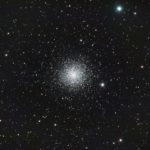NGC 7331 (Caldwell 30) is a spiral galaxy about 46 million light years away in the constellation of Pegasus. It is a vibrant and colorful galaxy, often referred to as the Milky Way’s “twin” due to it being of a similar size and mass to our own galaxy. It is visible in amateur telescopes as a faint smudge if the sky is dark.
In the images below, the smaller galaxies to the left of the main galaxy are a chance line-of-sight alignment. These four galaxies are much more distant than NGC 7331 (about 320 million light years) and are nothing to do with the main galaxy. This collection of galaxies (NGC 7331 and the distant background galaxies are collectively referred to as the Deer Lick Group named after the Deer Lick gap in the mountains of North Carolina by astronomer Tomm Lorenzin who liked to observe from there.
Image Technical Data
Imaged over two nights on the 21st and 22nd September 2019 with my TEC 140 refractor from my backyard in Nottingham, UK. I used my Atik 460 CCD camera with Astrodon LRGB Generation 2 E-series 1.25″ filters. I used my MESU 200 mount that was guided via OAG.
Luminance 24 x 600s 1×1; Red 12 x 300s 2×2; Green 12 x 300s 2×2; Blue 12 x 300s 2×2
Total Integration of the data set is seven hours. It would benefit from the addition of more data but I am quite content with it now as it is.
Image processing with PixInsight and data collected with Sequence Generator Pro.
In the second version I processed the data slightly differently with a bit more focus on the red spectrum of the galaxy in the absence of any Hydrogen Alpha data. However, I think this is slightly too much and I prefer the first image as more natural. However, I include it here as an interesting contrast in the different approaches that can be taken to astronomy image processing with the same data set with differing emphases that can be quite subjective.







Comments are closed.